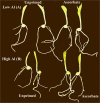Dry Priming of Maize Seeds Reduces Aluminum Stress
- PMID: 26714286
- PMCID: PMC4694655
- DOI: 10.1371/journal.pone.0145742
Dry Priming of Maize Seeds Reduces Aluminum Stress
Abstract
Aluminum (Al) toxicity is directly related to acidic soils and substantially limits maize yield. Earlier studies using hormones and other substances to treat the seeds of various crops have been carried out with the aim of inducing tolerance to abiotic stress, especially chilling, drought and salinity. However, more studies regarding the effects of seed treatments on the induction of Al tolerance are necessary. In this study, two independent experiments were performed to determine the effect of ascorbic acid (AsA) seed treatment on the tolerance response of maize to acidic soil and Al stress. In the first experiment (greenhouse), the AsA seed treatment was tested in B73 (Al-sensitive genotype). This study demonstrates the potential of AsA for use as a pre-sowing seed treatment (seed priming) because this metabolite increased root and shoot growth under acidic and Al stress conditions. In the second test, the evidence from field experiments using an Al-sensitive genotype (Mo17) and an Al-tolerant genotype (DA) suggested that prior AsA seed treatment increased the growth of both genotypes. Enhanced productivity was observed for DA under Al stress after priming the seeds. Furthermore, the AsA treatment decreased the activity of oxidative stress-related enzymes in the DA genotype. In this study, remarkable effects using AsA seed treatment in maize were observed, demonstrating the potential future use of AsA in seed priming.
Conflict of interest statement
Figures










Similar articles
-
Seed Priming with Melatonin Improves the Seed Germination of Waxy Maize under Chilling Stress via Promoting the Antioxidant System and Starch Metabolism.Sci Rep. 2019 Oct 21;9(1):15044. doi: 10.1038/s41598-019-51122-y. Sci Rep. 2019. PMID: 31636312 Free PMC article.
-
Optimizing water relations, gas exchange parameters, biochemical attributes and yield of water-stressed maize plants through seed priming with iron oxide nanoparticles.BMC Plant Biol. 2024 Jun 29;24(1):624. doi: 10.1186/s12870-024-05324-w. BMC Plant Biol. 2024. PMID: 38951758 Free PMC article.
-
"On-off" thermoresponsive coating agent containing salicylic acid applied to maize seeds for chilling tolerance.PLoS One. 2015 Mar 25;10(3):e0120695. doi: 10.1371/journal.pone.0120695. eCollection 2015. PLoS One. 2015. PMID: 25807522 Free PMC article.
-
Seed priming to alleviate salinity stress in germinating seeds.J Plant Physiol. 2016 Mar 15;192:38-46. doi: 10.1016/j.jplph.2015.12.011. Epub 2016 Jan 16. J Plant Physiol. 2016. PMID: 26812088 Review.
-
Seed Priming: A Feasible Strategy to Enhance Drought Tolerance in Crop Plants.Int J Mol Sci. 2020 Nov 4;21(21):8258. doi: 10.3390/ijms21218258. Int J Mol Sci. 2020. PMID: 33158156 Free PMC article. Review.
Cited by
-
Leaf 13C and 15N composition shedding light on easing drought stress through partial K substitution by Na in eucalyptus species.Sci Rep. 2021 Oct 11;11(1):20158. doi: 10.1038/s41598-021-99710-1. Sci Rep. 2021. PMID: 34635753 Free PMC article.
-
Temporal dynamic responses of roots in contrasting tomato genotypes to cadmium tolerance.Ecotoxicology. 2018 Apr;27(3):245-258. doi: 10.1007/s10646-017-1889-x. Epub 2018 Jan 2. Ecotoxicology. 2018. PMID: 29294240
-
Abscisic acid-deficient sit tomato mutant responses to cadmium-induced stress.Protoplasma. 2017 Mar;254(2):771-783. doi: 10.1007/s00709-016-0989-4. Epub 2016 Jun 4. Protoplasma. 2017. PMID: 27263082
-
Unravelling homeostasis effects of phosphorus and zinc nutrition by leaf photochemistry and metabolic adjustment in cotton plants.Sci Rep. 2021 Jul 2;11(1):13746. doi: 10.1038/s41598-021-93396-1. Sci Rep. 2021. PMID: 34215834 Free PMC article.
References
-
- Kochian LV, Hoekenga OA, Piñeros MA. How do crop plants tolerate acid soils? Mechanisms of aluminum tolerance and phosphorous efficiency. Annu Rev Plant Biol. 2004; 55: 459–493. - PubMed
-
- Ma JF. Syndrome of aluminum toxicity and diversity of aluminum resistance in higher plants. Int Rev Cytol. 2007; 264: 225–252. - PubMed
-
- Lawrence GB, David M, Shortle W. A new mechanism for calcium loss in forest-floor soils. Nature. 1995; 378: 162–165.
-
- Valadez-González N, Colli-Mull JG, Brito-Argáez L, Muñoz-Sánchez JA, Aguilar JJZ, Castaño E, et al. Differential effect of aluminum on DNA synthesis and CDKA activity in two Coffea arabica cell lines. J Plant Growth Regul. 2007; 26: 69–77.
-
- Yi M, Yi H, Li H, Wu L. Aluminum induces chromosome aberrations, micronuclei, and cell cycle dysfunction in root cells of Vicia faba . Environ Toxicol. 2009; 98: 124–129. - PubMed
Publication types
MeSH terms
Substances
LinkOut - more resources
Full Text Sources
Other Literature Sources
Medical

